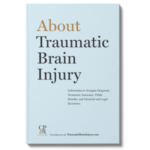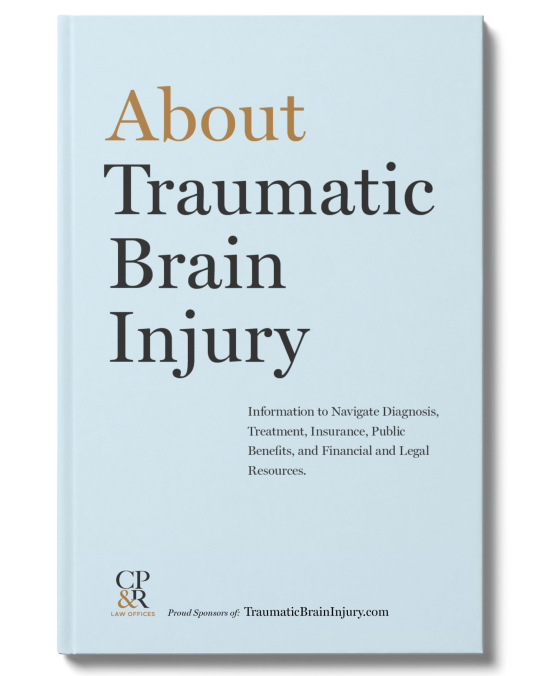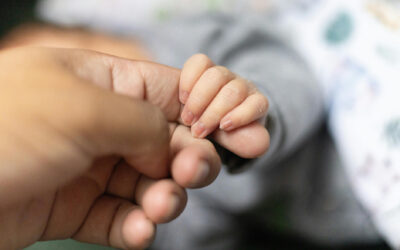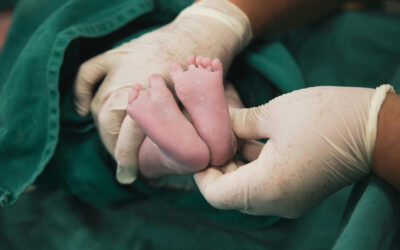Understanding Traumatic Brain Injuries to Children
Children’s traumatic brain injury (TBI) is a serious health and legal concern, and is especially concerning due to its potential long-term impact on a young person’s development, behavior, quality of life, and cost of care over a lifetime.
Request our Free Book on Traumatic Brain Injury

The instant a parent learns that their child has suffered a brain injury, the life of their child and their family changes. A severe brain injury is every parent’s worst nightmare and places anxiety and stress on the entire family. Parents carry the weight of making complex medical decisions, securing financial resources, and advocating for their child’s needs, not to mention the emotional turmoil, worry, and concern.

Parents and caregivers of children with TBI face challenges in learning how to care properly for their child. Parents and caregivers also experience lifelong stress in finding and providing proper care. And there are troublesome questions: Why was our child brain injured? Who will take care of our child if, as, and when we cannot? How will we pay for the lifetime of care required?
Key Facts
564,000
The number of children ages 0-19 seen annually in emergency departments for brain injury.
62,000
The number of children annually who require hospitalization for brain injury.
3,000
The number of children who die annually from complications of brain injury.
Sources: U.S. Centers for Disease Control and Prevention (CDC) and the Brain Injury Association of America
According to the U.S. Centers for Disease Control and Prevention (CDC) and the Brain Injury Association of America, each year, an average of 564,000 children ages 0-19 are seen in hospital emergency departments for brain injury and released, and approximately 62,000 require hospitalization. Sadly, these injuries lead to nearly 3,000 deaths each year.
While prevention and education always form the essential first line of defense in avoiding or reducing the risk of traumatic brain injuries or birth injury for children, early detection and treatment are crucial for the best possible outcomes if such an injury does occur.
Let’s take a closer look at some unique considerations related to TBI in children, and answer some of the top questions we see from parents, families, and caregivers.
What Is Traumatic Brain Injury?
The CDC defines a TBI as an injury that can “result from a bump, blow, or jolt to the head or body — or a penetrating head injury — that disrupts normal brain function”. It often begins with a primary injury that occurs at the moment of such an impact, but it can be followed by secondary damage resulting from complications like intracranial hematomas, cerebral ischemia, edema, vasospasms, and hypoxemia.
To learn more, read our articles What Is Traumatic Brain Injury? and Failure to Act: The Role of Medical Malpractice in the Onset of Brain Injury and Cerebral Palsy in Children
What Are the Leading Causes of Traumatic Brain Injury and TBI-Related Deaths in Children?
TBI is surprisingly common in children — occurring more often in boys than girls — and can result in anything from a mild concussion or contusion to a skull fracture, penetrating brain injury, hemorrhage, cerebral palsy, coma, or even death in severe cases.
Understanding the cause of a child’s brain injury is important to the emotional well-being of parents and caregivers. Research confirms that it is important for parents to understand the cause of their child’s injury, that parents have strong emotions about the causes of their child’s injuries, and that parents’ emotions affect the action that they take in relation to their child’s injury. This study reported that 92 percent of parents felt it was important to understand the causes of their child’s injury.
In their anger, sadness, and grief, some parents with children with catastrophic injuries sometimes blame others. Some parents believe the cause is their own failure to protect their child, and they feel guilt. Parents have lived with these feelings, often pent up, for years. Parents routinely consult personal injury attorneys many years after the injury to their child, looking for answers to questions that were never investigated at the time of the injury. Due to minor tolling statutes in these cases, the attorneys may still be able to file claims to provide financial assistance. Sometimes the investigation by experienced lawyers, the expert review, or the lawsuit itself provides comfort and brings closure.
Parents’ feelings about the cause of the injury contribute to the emotions they experience and the actions they take. According to the research cited above: “Parents’ stories around causal attribution can be heard and discussed, and working with their beliefs is seen as beneficial to the child’s development.” This applies not only to parents of children with TBI, cerebral palsy (CP), and spinal cord injuries but also to all parents of children who have suffered catastrophic injuries.
What Symptoms Should I Look For?
There are a variety of common signs and symptoms you should look for if you are concerned whether a child has consequences from a TBI. Be aware, however, that in addition to the conditions listed here, TBI can present in various other ways so you should always seek a thorough medical evaluation to err on the side of caution.
According to the Mayo Clinic and Cincinnati Children’s Hospital Medical Center, you should always keep in mind that infants and very young children with brain injuries cannot communicate headaches, sensory problems, confusion, and similar symptoms. The most common signs and symptoms of pediatric traumatic brain injury that you should watch for include:
- Headache(s)
- Sensitivity to light or sound
- Dilation of one or both pupils
- Nausea or vomiting
- Change in eating or nursing habits
- Loss of consciousness
- Fatigue
- Inability to awaken or other changes in sleeping patterns, such as trouble falling or staying asleep, or sleeping more or less than usual
- Dizziness
- Loss of balance and coordination, including trouble walking
- Ringing in ears
- Double or blurred vision
- Slurred speech
- Numbness or tingling in extremities
- Spasticity
- Muscle weakness
- Seizures
- Feeling foggy or confused
- Slow thinking or processing
- Memory issues
- Inability to concentrate
- Poor judgment
- Falling behind in school
- Feeling more sad, nervous, irritable, restless, impatient, or fussy than normal
- Persistent crying and inability to be consoled
- Lack of motivation or interest in performing their normal activities
- Loss of interest in favorite toys or activities
- Inability to tolerate daily routines
- Emotional outbursts or unusually bold behavior
Sources: Mayo Clinic and Cincinnati Children’s Hospital Medical Center
If My Child Sustains a Head Injury, What Can We Expect in Terms of Diagnosis & Treatment?
There are a variety of methods used by healthcare professionals to obtain an accurate pediatric traumatic brain injury diagnosis, including both physical and neurological clinical evaluations, as well as imaging such as CT scans or MRIs to assess the extent of the injury.
In addition to any abnormalities found on the imaging and evaluation, your healthcare provider will consider other factors, including any extended loss of consciousness, neurological symptoms exhibited at the time of injury, and memory loss resulting from or related to the injury itself.
Your healthcare provider team will then classify the injury as mild, moderate, or severe — typically based on the Glasgow Coma Scale — with TBI treatments and follow-up care designed accordingly. That may include any combination of the following procedures and services:
- Immediate Care — The first priority is always ensuring the child is breathing and maintaining blood flow to the brain.
- Medications — A variety of treatments can help manage symptoms such as pain, seizures, or spasticity.
- Hospitalization — In severe cases, monitoring and potential surgical intervention may be required.
- Rehabilitation — Physical, occupational, and speech therapy can help address any deficits resulting from the injury.
- Monitoring — Regular check-ups allow caregivers to monitor the patient’s recovery and address any ongoing issues.
- Support — Access to support services can help both the child and family cope with any long-term impacts of TBI.
What Long-Term Effects of a TBI Should We Be Concerned About?
The long-term prognosis for a child who has suffered a brain injury can vary significantly depending on several factors, including the type and severity of the injury, the region of the brain affected, the timing and effectiveness of the interventions provided, and the overall health of the infant. Long-term outcomes include:
- Cerebral Palsy: Infants who experience brain injury at birth are at risk of developing CP. Read more about TBI and Cerebral palsy here.
- Cognitive and Developmental Delays: Brain injuries can lead to cognitive impairment and developmental delays. Children may experience difficulties in areas such as learning, attention, and behavior, and these challenges can present as the child ages.
- Seizures: Some infants may develop epilepsy or seizure disorders because of brain injury. Seizures can vary in frequency and severity, and management may require medication and ongoing medical care.
- Speech and Language Delays: Depending on the areas of the brain affected, children may experience delays in speech and language development. Speech and language therapy can be beneficial in addressing these issues.
- Sensory Processing Issues: Children who have suffered brain injuries may also experience difficulties with sensory processing, which can affect how they respond to sensory stimuli and interact with their environment.
- Social and Emotional Challenges: Brain injuries may impact a child’s social skills and emotional development. These children may require support in developing healthy social relationships and managing emotions.
The overall prognosis for a child’s quality of life following a brain injury can vary widely. Some children may grow up to lead productive lives, while others with more severe injuries may require lifelong care and support. Early interventions, such as PT, OT, and ST, can significantly improve outcomes and help children reach their developmental milestones. Regular follow-up with health care providers, including neurologists, pediatricians, and therapists, is crucial in managing any ongoing challenges.
How Can I Reduce the Risk of My Child Suffering a Traumatic Brain Injury?
There are steps you can take to try to protect against these types of injuries.
- Teach all children and caregivers about important safety practices.
- Use properly installed, age-appropriate infant carriers and child safety seats that meet Federal Motor Vehicle Safety Standards every time your child rides in a car. If you have questions about proper installation, there are a variety of information sources (e.g., Safe Kids Worldwide and Buckle Up for Life) and professional technicians you can turn to for help.
- Ensure your child wears a properly fitted helmet certified by the U.S. Consumer Product Safety Commission (CPSC) when engaging in risky activities like biking, skiing, skateboarding, or playing an impact sport like ice hockey or football. Keep in mind that in most cases, different activities require different helmets based on impact resistance needs and other criteria. For guidance and current requirements, visit the CPSC website.
- Make environmental modifications in your home, such as removing tripping hazards, and ensure safe play areas by installing child-proof window guards and safety gates on stairways.
- Ensure that children live in an environment that is safe and free from abuse. If you need personal assistance or support — or witness a situation in which another child may be in physical danger in their own home — contact the National Domestic Violence Hotline immediately.
Financial Resources and Legal Support for Your Child
An individual family’s financial costs following a brain injury diagnosis are variable and depend upon many factors, but it may amount to millions of dollars, which includes benefits paid by private insurance, government insurance, benefits, and services. According to the CDC, the estimated lifetime costs of medical care in 2003 dollars in the US totaled $51.2 billion for people with intellectual disabilities, $11.5 billion for people with CP, $2.1 billion for people with hearing loss, and $2.5 billion for people with vision impairment. This is equivalent to approximately $134.7 billion in purchasing power in 2024.
After addressing emergency medical care, one of the first steps for parents of a child with a brain injury is to have the circumstances fully evaluated by a law firm experienced in handling brain injury cases. A full investigation of the facts is required.
Need help investigating your legal rights related to a traumatic brain injury?
Speak to an experienced brain injury attorney team like Cohen, Placitella & Roth.
For five decades, CPR has successfully represented individuals and families in TBI cases nationwide working with qualified co-counsel.


Get Our Free Traumatic Brain Injury Book
To learn more about Traumatic Brain Injury request our comprehensive book, available for free directly to your inbox



